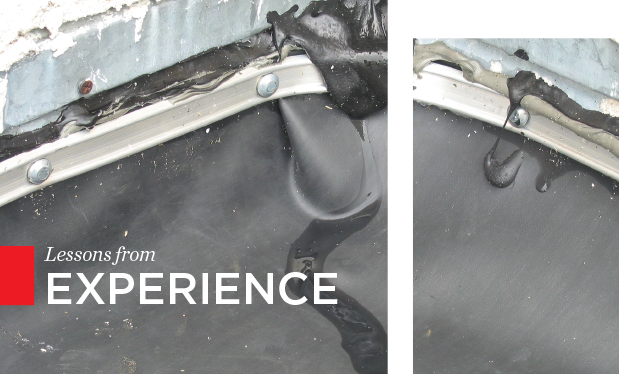The U.S. asphalt roofing industry is composed of seasoned, time-tested professionals who produce high-quality, durable products. ARMA recently asked nine of its members to examine how they are addressing modern challenges and opportunities and what they predict for the future regarding labor shortage, sustainability, weather events, codes and compliance, and what to expect from the asphalt roofing industry in the future.
Labor
The workforce shortage is one of the roofing industry’s greatest challenges not only on the roof but also in manufacturing, the supply chains, transportation and distribution. This across-the-board shortage has hindered many sectors as products, materials and supplies cannot reach destinations or be installed at the pace needed to meet project demand.
The idea that college is necessary to provide for one’s future has pushed many young Americans into the secondary education system. In 2016, the Pew Research Center estimated around 40% of adults between 25 and 29 years old held a bachelor’s degree or higher. This is significantly different from the Baby Boomer generation where college graduates stood around 21%. Now in 2019, the Bureau of Labor Statistics estimates roughly two-thirds of high school graduates plan to attend college.
In some instances, this has indirectly hidden viable careers—like roofing—from those who may only see college as the next step. According to the federal government and as reported by The Washington Post, more than half the students who go to college drop out within six years. A degree is an impressive life achievement, but it isn’t a prerequisite for a successful, lucrative career.
One of the workforce shortage’s most apparent effects is the rising cost of projects. As qualified labor becomes a rarer resource, project timelines and costs increase. To offset this, contractors are increasingly employing labor-saving strategies to reduce timelines.
To directly combat the labor crisis, manufacturers and trade associations must continue working with vocational, trade and high schools to build interest in the roofing industry as a profession. What many young people may not realize—and what all roofing professionals need to better advocate—is roofing is an excellent industry for professional growth, career advancement and financial success.
According to Tradesmen International,® a Macedonia, Ohio-based staffing resource company, during the next several years, the construction industry is expected to grow at a rate of 4.5% per year. Whether it’s on the roof, in manufacturing or in the various supporting elements, there is abundant opportunity because homes, businesses, schools and hospitals will always need roofs.
And NRCA and manufacturers have developed training programs to train and certify workers. New workers can go from untrained to earning a paycheck in an incredibly short time when compared with the length of a secondary education.
Addressing this issue over the long term greatly depends on priming the interest of young Americans. But in terms of immediate needs, there are many qualified or willing-to-learn immigrants seeking opportunities. Implementing supplementary H-2B seasonal worker visas for the roofing season would lessen the strain placed on the industry. However, there are an insufficient number of visas supplied, making a contractor’s ability to hire immigrants more difficult and preventing willing and able workers from contributing to local, state and national economies.
Associations are active in this arena, with NRCA petitioning the Department of Homeland Security and Department of Labor to increase visas and ARMA supporting the Workforce for an Expanding Economy Act (H.R. 1740) and the American Dream and Promise Act (H.R. 6). The workforce shortage can be lessened by ready and willing workers, but political action is needed to allow it to happen.
Sustainability
The most environmentally friendly roof is the one that needs to be repaired and replaced the least. The higher the durability, the fewer resources are consumed. In this sense, asphalt roofing products are durable, and asphalt roof systems offer excellent durability-to-price ratios.
Some have argued against asphalt’s sustainability because it’s created during the petroleum refining process. Yet even if asphalt didn’t have a use, refineries still would produce it as a byproduct; the asphalt roofing industry makes beneficial use of a material that otherwise would end up as waste and turns it into a durable, versatile roofing material.
Beyond durability and life cycle performance, there are environmentally conscious evolutions taking place in the asphalt roofing industry. When a trade is as time-tested as roofing, a perception that manufacturers resist change can grow. However, that’s simply not true for asphalt roofing.
Asphalt roofing manufacturers have embraced sustainable practices and processes from Environmental Product Declarations to helping projects achieve LEED® certification. There also is a constant effort to reduce carbon emissions, enhance product performance, reduce resource consumption and strengthen recycling programs. During the past several years, manufacturers have invested great effort and resources into asphalt shingle recycling programs.
According to the National Asphalt Pavement Association, 994,000 tons of recycled asphalt shingles were used in road paving projects during 2017. That same year, shingle recycling eliminated the need for 188,000 tons (1 million barrels) of asphalt binder and 472,000 tons of aggregate, which is estimated to hold a value around $74 million. In addition, the National Asphalt Pavement Association says asphalt shingle recycling has grown 32% during the past decade and the industry is working hard to increase this further, thereby saving resources and energy as well as reducing waste. Unlike some materials, there is infrastructure in place to recycle asphalt shingles at the end of their life cycles.
For the future of sustainability, asphalt roofing manufacturers widely believe that during the next five years, vegetative roof systems will grow in popularity. Some U.S. cities have issued mandates requiring energy-efficient or vegetative roof systems.
On the commercial side, many companies are using vegetative systems to cut energy waste. SL Green Realty Corp., the largest commercial landlord in New York City, is working to reach a 30% to 50% greenhouse gas emission reduction during the next decade. Vegetative roof systems with APP polymer-modified bitumen are playing a significant role in reaching that milestone.
Overall, from 2019–2023 The Freedonia Group, Cleveland, an international business research company, estimates vegetative roof systems will grow 11% each year. ARMA members are excited asphalt roofing is playing and will continue to play such an important role in this area.
Weather
Extreme weather continues to strike North America, affecting homeowners and commercial building owners alike. This has presented a significant challenge to rebuild affected communities, as well as a longer-term challenge to mitigate the damage from future natural events.
The tragic 2017 hurricane season included Hurricanes Harvey, Irma and Maria and caused a combined total of $265 billion in damage. Unfortunately, this trend may become a new norm; in the past 24 years, The Guardian reports there have been 16 above-normal hurricane seasons and hurricanes themselves are getting stronger, lasting longer and producing more rainfall. As a result, the asphalt roofing industry is innovating and continuing to help contractors learn and practice correct installation techniques. These enhancements will help ensure asphalt roof systems are properly prepared for storms.
One significant, industrywide challenge is combating incorrect or misinformed opinions about asphalt roofing in light of natural occurrences. Hurricanes are powerful, destructive forces, and no type of construction or roof system is 100% immune, not even specially designed hurricane-resistant structures.
But there are shingles that meet or exceed the wind classification for every area of the U.S. Asphalt shingles can meet every wind zone requirement from Class D (appropriate for areas experiencing 90-mph winds) all the way up to Class H (appropriate for areas experiencing 150-mph winds). As recommended by the Federal Emergency Management Agency, shingles must pass ASTM D3161, “Standard Test Method for Wind-Resistance of Steep Slope Roofing Products (Fan-induced Method),” and ASTM D7158, “Standard Test Method for Wind Resistance of Asphalt Shingles (Uplift Force/Uplift Resistance Method).”
Issues arise for any roof system or material when components are installed incorrectly or installed too hastily as a result of timelines motivated by labor shortage. In many instances after natural events, it has been found asphalt shingles and other roofing materials were installed incorrectly from the beginning, as concluded by FEMA and as observed by ARMA’s technical team during post-storm investigations.
However, manufacturers and ARMA believe these storms are a serious challenge and product innovation is one of the best ways to ensure asphalt roof systems resist increasingly destructive natural disasters. Shingle manufacturers are making strategic improvements to existing lines to bolster storm resilience. For example, nailing surfaces have been strengthened to improve fastening power and nail grip, reducing the potential for nail pull-through or shingle blow-off events. Sealant strips are thicker and bond more aggressively, creating a vigorous, stable bond to the shingles below. These enhancements help build a roof system’s defense against uplift and wind-driven water penetration.
The challenge of hail is ever-present, too. Similar to hurricanes, hailstorms regularly threaten to damage metal, tile or single-ply roof systems. For example, FM Approvals reports insurance losses from hailstorms topped $10 billion in 2018, a trend for the past 11 years. Hailstorms also account for 70% of the average annual property loss from convective storms in the U.S., according to the National Center for Atmospheric Research.
In response, the asphalt roofing industry is improving the strength of its already impact-resistant roofing products. Especially in the low-slope asphalt roofing realm, multi-ply asphaltic sheets such as SBS-polymer modified bitumen are being tested and rated for Class 1-VSH, very severe hail.
This newer testing method fires 2-inch ice balls at a velocity of 152 to 160 feet per second using compressed air, generating an impact energy of 53 to 58 foot-pounds. This is roughly equivalent to the impact a 2 1/2-inch hailstone (about the size of a baseball) typically would generate. For comparison, to achieve Class 1-MH (moderate hail) rating, steel balls are dropped 81 feet onto a roofing material, generating an impact energy of about 8 foot-pounds. Strides like these are helping ensure asphalt roof systems are adequately prepared for future threats.
Codes and compliance
Many changes came to the industry with the 2016 edition of ASCE/SEI 7, “Minimum Design Loads and Associated Criteria for Buildings and Other Structures.” Some of these included new wind pressures and parameters that have brought new standards to the entire roofing industry.
An issue that arises from these changes and why industry voices like ARMA are so critical, is code inconsistency. A lack of uniformity among local codes can slow the rate of product advancement, innovation and the ability to meet demands across the continent. When uniform, improvements and evolutions in codes can help improve building practices overall, promote product innovation and advance industries.
ARMA’s strong voice in code development is valuable because it helps ensure code updates or changes are realistic, data-supported and present a feasible timeframe. When these criteria are not met, arbitrary changes produce an environment where codes become increasingly inconsistent.
Although all regions are affected by changes in building codes and energy-efficiency standards, the West Coast and California continue to implement more stringent standards. For example, the city and county of Los Angeles recently increased the solar reflectance index requirement for steep-slope systems from 16 to 20. This will force manufacturers to innovate if they wish to continue to compete in this area.
Looking forward
The roofing industry’s greatest challenges stem from the workforce shortage, and manufacturers, distributors and contractors are feeling the pinch. All industry sectors need to work together to identify creative ways to build interest in the roofing profession and find ways to facilitate the introduction of legal immigrants with work visas. To tackle such a widespread issue, effort is required at the community level all the way up to leveraging our industry’s voice in the federal legislative process. In our communities, we need to encourage our family members, neighbors and friends to consider high-paying, stable trade professions. We all have a role in proving other lucrative options exist in the roofing industry from manufacturing to roof system installation.
Challenges also exist in the political environment where tariffs increasingly affect raw materials and other supplies, giving the market a sense of volatility. Because this issue is evolving, there has been a negative effect on buyers’ confidence and more long-term effects may begin to develop.
In terms of opportunities, there are changes occurring that are exciting and game-changing. Some have speculated the changes happening now in asphalt roofing are as significant as the conversion from felt to fiberglass. For steep-slope roof systems, evolutions in surfacing technologies have produced algae-resistant and reflective granules that still provide asphalt shingles’ tremendous aesthetic value. In the low-slope arena, installation and application techniques are advancing rapidly; self-adhering membranes, cold-applied systems and environmentally friendly adhesives are all making enormous headway.
Overall, the asphalt industry has created high-quality, durable and reliable products to meet the labor, weather, sustainability and code evolutions across North America. To some degree, these changes have pushed the industry into unexplored territory as manufacturers navigate the new landscape.
Tremendous potential and innovative spirit exist from SBS polymer-reinforced asphalt shingles to multi-ply sheets certified for extreme hail. During the next five years, we may experience the next leap in asphalt roofing technology as manufacturers develop high-performing, durable, weather-resistant and easy-to-install asphalt roof systems.
Reed Hitchcock is ARMA’s executive vice president.
The following ARMA members contributed to this article:
Building Products of Canada Corp.
CertainTeed Corp.
Continental Materials Inc.
GAF
IKO®
Owens Corning®
PABCO® Roofing Products
Polyglass U.S.A., Inc.
SOPREMA® Inc.



